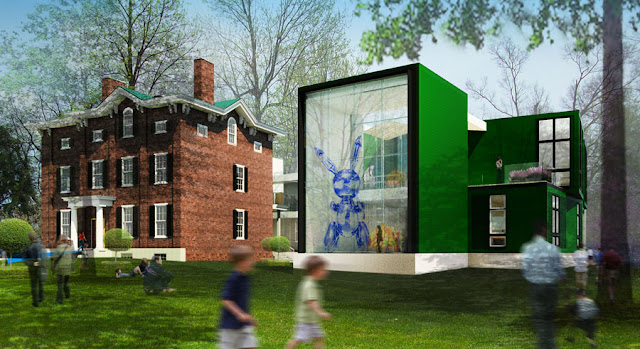 |
| Architect's Rendering. LASC. |
The Home
In 1847, George B. Kinkead had constructed a Greek Revival two-story townhouse and the home was adapted at least twice during the family's ownership. Around the time of the Civil War, the building was "Italicized" "with the addition of a third-floor attic and probably a two-story section on the north side of the main block." |
| 362 N. Martin Luther King. UK Collections. |
It is believed that Thomas Lewinski was the architect for the original construction, and perhaps the "Italicization" as well.
George Blackburn Kinkead
George B. Kinkead was a lawyer to Abraham Lincoln and his family and was a forward-thinking attorney and denizen of Lexington in the mid-nineteenth century.As of 1855, he was one of three faculty members at Transylvania's Law Department where he taught "the practice of law, pleading and evidence, and the law of contract." By 1857, however, Kinkead had ended his affiliation with the Law Department and the department closed the following year. Although the need for lawyers remained, the academic approach to a legal education was not yet in vogue, but rather the "archaic apprenticeship system" remained the method of choice.
Unlike many of his contemporaries, he was both pro-Union and anti-slavery. After the war, he provided 11 acres of land around his home to freed slaves. This area became known as Kinkeadtown. As was written on this site in 2012, "Kinkeadtown comprises the heart of the East End, though there is scant evidence other than the expansive mansion of the old community." The Notable Kentucky African Americans Database * included this regarding Kinkeadtown:
Kinkeadtown was bottomland that included more recently Illinois, Kinkead, and Mosby Streets; it was around the area where Elm Tree Lane intersects with Fourth and Fifth Streets. The land had been subdivided by abolitionist George B. Kinkead in 1870 and sold exclusively to African Americans. Populated by about 20 families in 1880, it grew to include over 300 residents. The section of Elm Tree Lane and the remainder of Kinkeadtown, between Fourth and Fifth Streets, were purchased by the Lexington-Fayette Urban County Government in the 1990s. The shotgun and T-plan houses were demolished in preparation for the extension of Rose Street.Kinkead died in November 1877. His 1874 will left all of his assets to his "dear wife, absolutely" and directed that no appraisal be conducted. As noted previously, the Kinkead family remained in possession until the property became home to the Living Arts and Science Center.
A Blue Grass Trust deTour is scheduled for next week to explore the adaptive reuse of this antebellum home as well as the merging of the property with the recent contemporary addition. The import of Kinkeadtown will also be discussed. More details are included below...
Eblen, Tom. Living Arts & Science Center plans $5 million expansion project. Lexington Herald-Leader, Nov. 16, 2011.
National Register of Historic Places Nomination Form. Kinkead House (PDF). May 1982.
Sloan, Jason. Kinkead House, home of Living Arts and Science Center, ready for contemporary architecture addition. Kaintuckeean, Feb. 2012.
Wright, John D., Jr. Transylvania: Tutor to the West. (Transylvania University: Lexington, 1975).

Comments